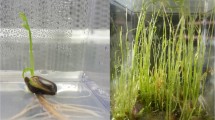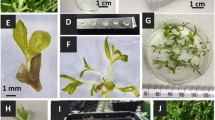Abstract
Helonias bullata, commonly known as swamp pink, is a perennial rhizomatous herb native to the eastern coast of the United States that is found mainly in forested wetlands, swamps, and mountain bogs. Habitat destruction has caused H. bullata to become rare, and it is federally listed as threatened. Protocols were developed for in vitro germination, shoot micropropagation, shoot establishment in soil, and seed cryopreservation that will assist in the safeguarding and conservation of dwindling natural populations. Seeds were germinated in vitro on plant growth regulator (PGR)-free 1/3-strength Murashige and Skoog (MS) medium after seed sterilization in H2O2 and used for establishment of shoot cultures. Shoot multiplication and elongation occurred on 1/3-strength MS medium containing 0.25–1 mg/l kinetin or 1–2 mg/l trans-zeatin followed by growth on PGR-free medium. All shoots (100%) rooted when planted directly into potting media. Rapid-immersion seed cryopreservation resulted in statistically significant increases in germination in vitro or in potting mix compared to control treatments. H. bullata seeds share characteristics of both orthodox and recalcitrant seeds including rapid loss of viability over time, survival at 5°C, and survival after cryopreservation. Therefore, they are most accurately classified as intermediate-type seed.







Similar content being viewed by others
References
Argo B (2004) Understanding pH management and plant nutrition. Part 5: choosing the “best” fertilizer. J Int Phalaenopsis Alliance 13(4):1–6
Black M, Bewley JD, Halmer P (2006) The encyclopedia of seeds: science, technology and uses. CABI, Oxfordshire
Chin HF, Krishnapillay B, Stanwood PC (1989) Seed moisture: recalcitrant vs. orthodox seeds. CSSA Special Publication no. 14. Crop Science Society of America, Madison, pp 15–22
Dussert S, Chabrillange N, Rocquelin G, Engelmann F, Lopez M, Hamon S (2001) Tolerance of coffee (Coffea spp.) seeds to ultra-low temperature exposure in relation to calorimetric properties of tissue water, lipid composition, and cooling procedure. Physiol Plant 112:495–504
Ellis RH, Hong TD, Roberts EH (1990) An intermediate category of seed storage behaviour? I. Coffee. J Exp Bot 41:1167–1174
Engelmann F (2000) Cryopreservation of tropical germplasm. In: Engelmann F, Takagi H (eds) Current research progress and application. Japan International Research Center for Agriculture Sciences and International Plant Genetic Resources Institute, Rome, pp 8–20
Engelmann F (2011a) Cryopreservation of embryos: an overview. Methods Mol Biol 710:155–184
Engelmann F (2011b) Use of biotechnologies for the conservation of plant biodiversity. In Vitro Cell Dev Biol Plant 47:5–16
Fay MF (1992) Conservation of rare and endangered plants using in vitro methods. In Vitro Cell Dev Biol Plant 28:1–4
Figueira A, Whipkey A, Janick J (1991) Increased CO2 and light promote in vitro shoot growth and development of Theobroma cacao. J Amer Soc Hortic Sci 116:585–589
Godt MW, Hamrick JL, Bratton S (1995) Genetic diversity in a threatened wetland species, Helonias bullata (Liliaceae). Conserv Biol 9:596–604
Hong TD, Linington S, Ellis RH (1998) Compendium of information on seed storage behaviour, vol 2 vol. Kew Publishing, London
Johnson T, Cruse-Sanders JM, Pullman GS (2012) Micropropagation and seed cryopreservation of the critically endangered species Tennessee yellow-eye grass, Xyris tennesseensis Kral. In Vitro Cell Dev Biol Plant 48:369–376
Kaeppler SM, Kaeppler HF, Rhee Y (2000) Epigenetic aspects of somaclonal variation in plants. Plant Mol Biol 43:179–188
Khanna S, Jenkins H, Bucalo K, Determann RO, Cruse-Sanders JM, Pullman GS (2014) Effects of seed cryopreservation, stratification and scarification on germination for five rare species of pitcher plants. CryoLetters 35:29–39
Maddox D (1990) Helonias bullata recovery research: interim report. Maryland Department of Natural Resources, Annapolis
Murashige T, Skoog F (1962) A revised medium for rapid growth and bioassays with tobacco tissue cultures. Physiol Plant 15:473–497
NatureServe (2013) NatureServe Explorer: An online encyclopedia of life [web application]. Version 7.1. NatureServe, Arlington, Virginia; http://www.natureserve.org/explorer. Cited 27 August 2013
Northcutt NC, Davies D, Gagliardo R, Bucalo K, Determann RO, Cruse-Sanders JM, Pullman GS (2012) Germination in vitro, micropropagation and cryogenic storage for three rare pitcher plants: Sarracenia oreophila (Kearney) Wherry (federally endangered). S. leucophylla Raf. and S. purpurea spp. venosa (Raf.) Wherry. HortSci 47:74–80
Peddaboina V, Thamidala C, Karampuri S (2006) In vitro shoot multiplication and plant regeneration in four Capsicum species using thidiazuron. Sci Hortic 107:117–122
Pence VC (1991) Cryopreservation of seeds of Ohio native plants and related species. Seed Sci Technol 19:235–251
Pritchard HW (2007) Cryopreservation of desiccation-tolerant seeds. Methods Mol Biol 368:185–201
Pullman GS, Chopra R, Chase KM (2006) Loblolly pine (Pinus taeda L.) somatic embryogenesis: Improvements in embryogenic tissue initiation by supplementation of medium with organic acids, vitamins B12 and E. Plant Sci 170:648–658
Pullman GS, Johnson S, Van Tassel S, Zhang Y (2005) Somatic embryogenesis in loblolly pine (Pinus taeda L.) and Douglas fir (Pseudotsuga menziesii): improving culture initiation with MES pH buffer, biotin, and folic acid. Plant Cell Tissue Organ Cult 80:91–103
Reed B (2001) Implementing cryogenic storage of clonally propagated plants. CryoLetters 22:97–104
Reed BM, Sarasan V, Kane M, Bunn E, Pence VC (2011) Biodiversity conservation and conservation biotechnology tools. In Vitro Cell Dev Biol Plant 47:1–4
Salomão A (2002) Tropical seed species’ responses to liquid nitrogen exposure. Braz J Plant Physiol 4:133–138
Sarasan V, Ryan C, Ramsay MM, Atherton C, McMichen M, Prendergast G, Rowntree JK (2006) Conservation in vitro of threatened plants—progress in the past decade. In Vitro Cell Dev Biol Plant 42:206–214
Sutter R (1982) The distribution and reproductive biology of Helonias bullata L. in North Carolina. North Carolina Department of Agriculture, Plant Industry Division, Raleigh
USFWS (1991) Swamp pink (Helonias bullata) recovery plan. US Fish and Wildlife Service, Region 5, Newton Corner
USFWS (2007) Five year review—Swamp pink (Helonias bullata). US Fish and Wildlife Service, Pleasantville
Wall M (2009) Seed collection guidelines for California native plant species. Seed Conservation Program, Rancho Santa Ana Botanic Garden http://www.rsabg.org/documents/horticulture/Seed%20Collecting%20and%20Storage%20Guidelines.pdf. Cited 27 Aug 2013
Acknowledgements
We thank Bill Brumback and the New England Wildflower Society and Tom Patrick from the Georgia Department of Natural Resources for providing seeds. The authors gratefully acknowledge the help of Kylie Bucalo for student training, laboratory infrastructure maintenance, and media preparation. We also thank the Georgia Institute of Technology for providing materials and supplies for undergraduate research in support of this project and the Greenville Zoo Conservation Fund for an award to help carry out the research.
Author information
Authors and Affiliations
Corresponding author
Additional information
Editor: John Finer
Rights and permissions
About this article
Cite this article
Perullo, N., Determann, R.O., Cruse-Sanders, J.M. et al. Seed cryopreservation and micropropagation of the critically endangered species swamp pink (Helonias bullata L.). In Vitro Cell.Dev.Biol.-Plant 51, 284–293 (2015). https://doi.org/10.1007/s11627-015-9679-8
Received:
Accepted:
Published:
Issue Date:
DOI: https://doi.org/10.1007/s11627-015-9679-8




